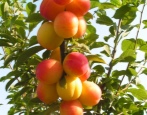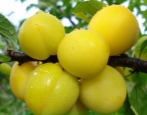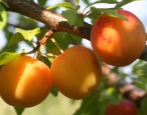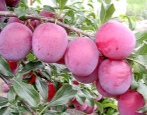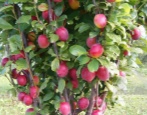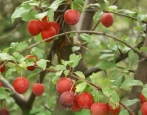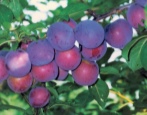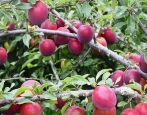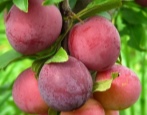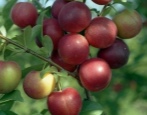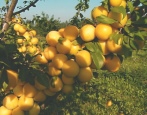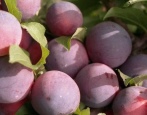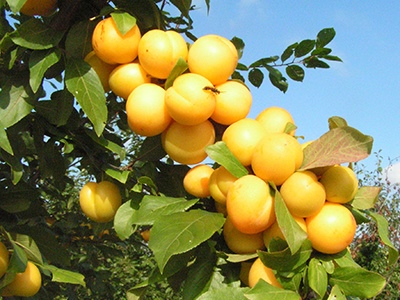
- Name synonyms: Lodva
- Appeared when crossing: Wind x Olympic
- Growth type: medium-sized
- Self-fertility: self-infertile
- Fruit size: large
- Yield: fruitful
- Appointment: for fresh consumption
- Fruit weight, g: 36
- Fruit shape: rounded
- Fruit color: yellow
Lodva variety is a large-fruited variety of Russian plum, also called diploid plum or hybrid cherry plum. Differs in early maturity and large-fruiting, winter hardiness and high-yielding capacity. The fruits are consumed fresh, dried, used for the preparation of compotes and wines, jams, confitures, pastilles, marmalade.
Breeding history
A hybrid of the Belarusian selection appeared on the basis of the RPU "Institute of Fruit Growing" as a result of the cross-pollination of the Vetraz and Olympic varieties. The authors are V. Matveev, M. Kastritskaya, N. Karpenko. Included in the State Register in 2011.
Description of the variety
The tree is medium-sized, reaching 4-5 m, the height of the plant often depends on the type of rootstock. Crohn round-pyramidal medium thickening. The bark on the trunk and branches is smooth, gray. Shoots are thin, straight, brown-brown. The leaves are small, elongated-oval, smooth, shiny, dark green. Flowers are small, white, double.
Blooms in May, flowers do not suffer from recurrent frosts. The tree has a lifespan of about 25-30 years. The variety has a high self-regeneration ability.
Fruit characteristics
The fruits are large in size, weigh an average of 36 g, rounded, bright yellow in color with a deep depression dividing the cherry plum into two identical halves. The pulp is soft, very juicy, with a caramel aroma, the stone is small, well separated. Skin with a whitish waxy bloom, dense. Well transported, stored for about 5 days in a cool dry place.
Taste qualities
Dessert taste, sweet, with a slight sourness. Fruits contain a lot of carotene. Tasting score - 4.9 points.
Ripening and fruiting
The hybrid begins to bear fruit for 2-3 years after planting, then the crop bears regularly. It is considered early ripe in terms of ripening - it starts from the end of July and lasts until mid-August, harvested in several stages. Ripe cherry plum begins to crumble.
Yield
Productivity is good: for 3-4 years, a tree can bring 4-5 kg, 35-40 kg are removed from a 5-6 year old.
Growing regions
Suitable for planting in central Russia, can be grown in Siberia. The hybrid bears fruit successfully in Belarus and Ukraine, as well as in the Baltic countries.
Self-fertility and the need for pollinators
A self-fertile variety, replanting of other pollinating varieties is required - Mara, Asaloda, Traveler.
Growing and care
Planting is carried out in early spring before bud break, seedlings with a closed root system can be planted all season until the end of September. A place for a seedling is chosen sunny, sheltered from the wind, on the southern or southwestern side of the site, preferably next to a house or a blank fence.
Groundwater should not be located closer than 2 meters from the surface. Cherry plum prefers the sun, but grows well in partial shade. The sun plays a decisive role in the ripening of fruits: the more it falls on the branches, the faster the harvest ripens and the berries become sweeter.
A planting pit is made 60x60 cm in size, 60 in depth. It is planted according to a 5x3 m scheme. A fertile substrate is poured at the bottom. Sour soil is deoxidized with dolomite flour.The rest of the planting is carried out in the same way as for other types of large-fruited hybrid cherry plum.
Unpretentious hybrid, does not require special care. Moderate watering is recommended. They are fed 3 times throughout the year: in early spring, while the snow has not melted yet, during the growth of the ovaries - in June, during the laying of fruit buds for the next harvest - in July.
The crown must be formed. In the early years, they are pruned, leaving strong skeletal branches. Annual growth is shortened every year. In August, the tops of young growing shoots are pinched.
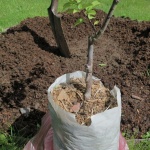
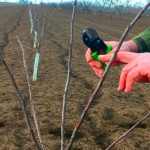
Disease and pest resistance
The variety has good immunity to clasterosporium disease. It is prone to be amazed by moniliosis and coccomycosis; for prophylaxis, it is treated with Horus in several steps: before flowering, then during the formation of buds. For powdery mildew and scab use the drug "Skor".
Pests include aphids, moths, and brown plum sawflies. For protection from insects, "trapping belts" are put on the trees.
Resistance to soil and climatic conditions
The variety is considered winter-hardy, tolerates frosts well down to -35 degrees. The crop is negatively affected by the sudden temperature changes from February to April, which can damage wood and flower buds. The hybrid is moderately resistant to drought; in very hot and dry summers, regular irrigation will be required. It can grow on any type of soil, but loose fertile loamy soil with neutral acidity is recommended.

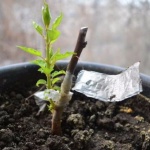
Review overview
Some gardeners call this variety the apricot plum for its characteristic yellow color and sweet-sour taste. Lodva brings in a lot of crops every year and tolerates frosty winters well. Among the disadvantages is the tendency to shedding and the appearance of rot on the crumbling cherry plum.

